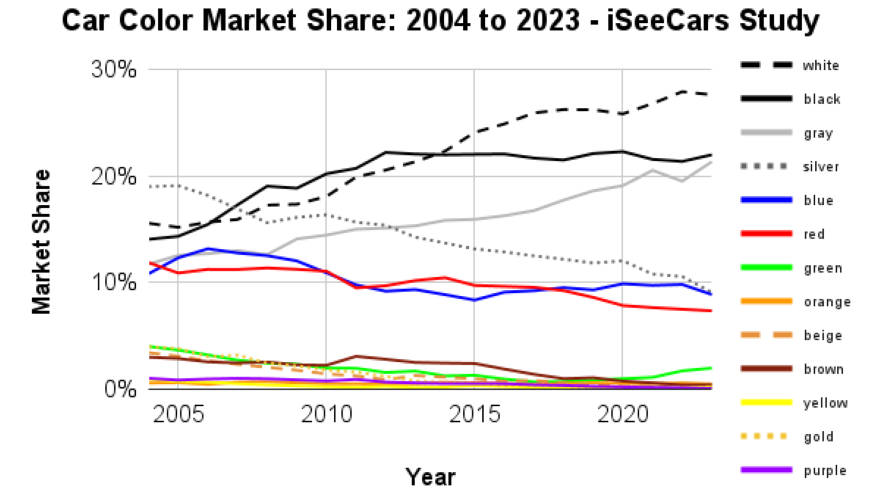Cars getting less colorful, study shows

Image courtesy of iSeeCars.
By subscribing, you agree to receive communications from Auto Remarketing and our partners in accordance with our Privacy Policy. We may share your information with select partners and sponsors who may contact you about their products and services. You may unsubscribe at any time.
We tend to think of the past as black and white, while the present shines in living color.
When it comes to cars, though, that trend is heading in the opposite direction.
Grayscale colors (white, black, gray and silver) are not only by far the most popular hues for cars, that popularity continues to grow, according to the latest study by iSeeCars.
The analysis of more than 20 million used vehicles from model years 2004-2023 sold from January 2023 to April 2024 found 80% of them are one of the grayscale shades compared to 60.3% in 2004, while the market share for non-grayscale vehicles has plummeted from almost 40% to 20%.
That means there are just half as many colorful cars on the road now as there were 20 years ago.
“Colorful cars appear to be an endangered species,” iSeeCars executive analyst Karl Brauer said in an analysis. “Despite a diverse palette being offered by automakers, there are far fewer non-grayscale cars sold today. They’ve lost half their market share over the past 20 years, and they could become even rarer in another 20 years.”
Subscribe to Auto Remarketing to stay informed and stay ahead.
By subscribing, you agree to receive communications from Auto Remarketing and our partners in accordance with our Privacy Policy. We may share your information with select partners and sponsors who may contact you about their products and services. You may unsubscribe at any time.
White is currently the top vehicle color, having passed black some 10 years ago, Brauer said. It has a 27.6% market share, up 77.4% since 2004. Black is next at 22.0%, followed by gray (21.3%), silver (9.1%), blue (8.9%), red (7.3%) and green (2.0%). No other color has more than 0.5% market share.
White, black and gray are the only three colors to gain market share over the past 20 years — gray is up nearly 82% since 2004. The other grayscale color, silver, dropped 52.2% in that span and is now just 0.2% ahead of blue.
Gold (down 96.8%) and purple (down 92.7%) cars have become virtually extinct, while brown (86.5%), beige (85.3%) and yellow (75.7%) vehicles all lost more than three-fourths of their market share.
While green’s share fell 50.6% during the 20-year period, it has been making something of a comeback recently, rising slightly since 2020.
Grayscale’s dominance held around 80% over three of the four vehicle segments studied (passenger cars, SUVs and trucks), though blue’s market share held steady as it surpassed silver among trucks to break into that segment’s top four.
The only outlier was sports cars, in which grayscale still leads non-grayscale colors but with just 62.4% of the market, as red (14.3%) and blue (13.2%) crashed the top five, behind gray (20.1%), white (19.4% — up 209% since 2004) and black (19.4%).
While the number of colorful cars continues to fall, automakers are still offering a variety of hues – 6.7 colors for the average car model, compared to 7.1 in 2004.
“Will grayscale shades drive out all other car colors over the next 20 years?” Brauer wondered in the report. “A flattening of the curve in the past few years indicates a possible maximum market tolerance for those four colors.
“Whether driven by dealers ‘playing it safe’ by ordering only popular colors or consumers wanting to ensure maximum interest when it’s time to sell or trade in their vehicle, grayscale colors now represent the dominant spectrum in the car world.”
The full report is available here.


